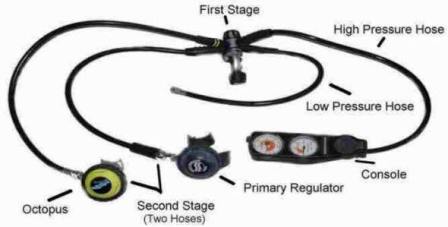Home › A to Z About Diving › Dive Equipment › Scuba Regulators
Scuba Regulators and Dive Gauges
The main purpose of a scuba regulator is to take high pressure air from your scuba tank and adjust it to the pressure that you need for breathing.
When you inhale (on demand) it supplies you with air and then directs your expired breath into the surrounding water as you exhale.
A regulator will also direct air to your BCD (buoyancy control device), diving instruments and dry suit if you’re using one.
Regulators usually consist of a First stage (which attaches to the scuba tank valve).
It reduces the cylinder air pressure to an intermediate pressure).
There's a Second stage with a mouthpiece which the diver breathes through.
The alternate second stage is a spare second stage for you or your buddy to use in a diving emergency situation.
The Low pressure hose supplies air to your BCD (and dry suit if you’re using one) so you can inflate it to increase your buoyancy.
Finally, a High pressure hose which sends air to your SPG (submersible pressure gauge) so you always know how much air you have left in your tank.
Pro Tip: Fitting Second stage hose protectors (usually made of black rubber) can help to extend the integrity of high and low pressure hoses.
How Scuba Regulators Work
A scuba regulator - also known as a demand valve - reduces the cylinder's high-pressure air to an ambient pressure that allows the diver to breathe the flow upon demand (inhalation).
Scuba Regulators have few moving parts, which makes them simple and reliable. The two stages of air pressure reduction take place primarily in the first stage and then further in the second stage at the mouthpiece.
 A one-way exhaust valve directs the exhaled air back into the water through small vents – known as open circuit.
A one-way exhaust valve directs the exhaled air back into the water through small vents – known as open circuit.
Scuba repair technicians should keep your regulators maintained and serviced regularly.
A divers' submersible pressure gauge or 'contents gauge' is a precision instrument that tracks how much air is remaining in the scuba tank during the dive.
Most divers will also have a depth gauge as part of the console so that he can monitor his depth and direction.
Gauge consoles tend to require delicate handling due to their analogue and digital design and should not be dropped or banged or allowed to dangle while diving to avoid damaging your gauges promoting passive interaction with fragile aquatic life.
Scuba Regulator Tip - Consider buying inexpensive hose protectors and attachment clips to protect your regulator and other scuba gear that dangles near to the sand and coral reefs.
Scuba Regulators |> Balanced vs. Unbalanced Regulators |> How Demand Valves Work |> Styles and Features
Scuba Diving Gauges
The three types of analogue dive pressure gauges are the submersible pressure gauge (SPG), a depth gauge (that indicates how deep you are diving), and a compass (e.g. underwater navigation device).
In scuba diving, each gauge system has a high pressure (HP) hose that connects the submersible pressure gauge to the tank.
Here's the thing:
Generally, modern scuba SPGs are available in two styles, the slim compact SPG, and the somewhat chunky "brass and glass" version (also called a Tech Gauge).
Most scuba diving gauges have a white or off-white face behind the plastic or tempered glass cover. Even so, some versions have a black face to help reduce glare from an underwater torch (e.g. when diving in dark environments).
The dial will be calibrated either in metric (BAR) or imperial increments (PSI). So for example, if you will be diving United Kingdom dive sites you most likely will opt for a diving pressure gauge set with a linear unit of pressure in bar.
There is some colour coding on modern scuba gauges. Hence, the last fifty (50) bar of gas pressure is coloured red to indicate the reserve (500-1,000 psi on imperial models).
Measuring Depth in Diving
Depth gauges are also available with metric or imperial calibrations that may be linear or nonlinear. By and large, shallower depth changes will produce bigger needle swings on the dial (e.g. when conducting the safety stop at 5 metres).
There should be two (2) needles, one is usually a bright orange pin that marks your maximum depth and a black pin that tracks your descents and ascents in real time.
It's quite common to see qualified divers using a triple gauge console set in a stiff rubber boot. This kind of design contains an inline SPG and depth gauge with an oil filled compass set at a 45° angle for easy "horizontal" use while swimming.
Pro Tip: You can use your thumb to rotate the centre grip anticlockwise and set both needles back to zero before you make the next dive.
Related Information and Help Guides
Scuba Regulators FAQ
There are several key features that all divers should know about their diving regulator. However, the most important feature is being able to deliver breathable air from the cylinder (gas tank).
Another section contains clear and simple answers to all the frequently asked questions about scuba diving regulators - especially useful for beginners.
Scuba Regulator Reviews
There are many different breathing devices on the market with varying designs and features suited for a range of specialised diving activities.
Information, evaluations, and customer reviews listed in this guide will help divers (especially beginners) when choosing the best dive regulator to suit their needs and price range.